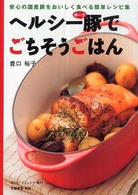- ホーム
- > 洋書
- > 英文書
- > Science / Mathematics
基本説明
Contents: 1. Introduction. 2. FIA Principles and Theories. 3. Components of FIA. 4. Detectors in FIA. 5. Modes of Operation. 6. Selectivity Enhancement, Matrix Modification and conversion Techniques. 7. Utilization of the Concentration Gradient, and more.
Full Description
This is a practical guide for first-time and experienced users of Flow Injection Analysis (FIA). It gives, not a detailed theoretical analysis, but a ``nuts and bolts'' approach to the description of the technique and how it can be utilized to solve analytical chemical problems. The advantages of flow injection, how, when, why and where it works are all fully explained. Criteria for the choice of hardware and useful hints for maintenance are provided. The large variety of detectors suitable to combine with FIA are discussed, as are special modes of operation, their advantages and their limitations, and also conversion of batch methods to FIA methods. Numerous in-depth descriptions of applications of FIA techniques in water, soil, pharmaceutical and industrial analysis are featured, and a complete bibliography is included. The authors have spent several years demonstrating, lecturing and using FIA and the basic outline of their book closely follows the schedule of the FIA workshops they have taught. It will be an invaluable tool for all chemists who perform analyses on a routine basis.
Contents
1. Introduction. Modernization of sample/solution handling techniques. Automated analysis in general (where, when, and why). Comparison of FIA versus HPLC, segmented continuous flow analyzers and robotics. Objectives. 2. FIA Principles and Theories. Batch methods. Segmented continuous flow analysis. Discrete analyzers. FIA. Controllable sample dispersion. Factors affecting controllable sample dispersion. Relationship between manifold design and chemistry. The gradient. 3. Components of FIA. Means for treatment and storage of solutions. Connection tubes. Liquid delivery units (pumps). Pump tubes (for peristaltic pumps). Injectors. Manifolds: for general purpose use; for mixing; for dilution; for gas diffusion; for dialysis; for liquid-liquid extraction. Column reactors. Other components. Commercially available flow injection analyzers. 4. Detectors in FIA. Detector requirements for FIA in comparison with HPLC. Peak height versus peak area. Spectrophotometry (UV and visible). Luminescent detection. Atomic spectroscopy. Electrochemical detection. Other detectors. 5. Modes of Operation. Basic modes. Special modes: one pump; two pumps. Dilution modes. Reverse flow, FIA. 6. Selectivity Enhancement, Matrix Modification and Conversion Techniques. Liquid-liquid extraction. Gas diffusion. Dialysis. Packed-bed reactors. 7. Utilization of the Concentration Gradient. FIA titrations. Gradient dilution. Stopped-flow. Gradient techniques based on penetrating zones (chasing zones). 8. Developing an FIA Method. Check list for method development. How to use the check list for method development: an example. Faultfinding during method development. 9. Water, Agriculture, Soil and Environment. Why FIA, when FIA for these samples. Phosphate (orthophosphate, phosphorus). Nitrate (total nitrogen). Ammonia (ammonia nitrogen, ammonium). Residual ozone. Sulfate. Alkalinity. Fluoride. Heavy metals. Cyanide. 10. Pharmaceutical, Clinical, Biotechnology. Determination of: codeine in pharmaceutical preparations; Lowry protein; creatinine; lactate; isoprenaline; penicillins; drugs with phenolic structure using the 4-aminoantipyrine method. 11. Food and Feed. Determination of starch in food and feed products. Determination of caffeine in coffee and tea. Oxidized ketone bodies in milk. Sulfite and sulfur dioxide in beverages. Determination of potassium bromate in flour. Selenium in biological material. 12. Process and Quality Control. FIA components in process control. Operational FIA modes in process control. Determination of cyanide. Nonaqueous process control FIA. Determination of bases. (All chapters have an Introduction and References section). Appendix A. Bibliography - Subject Index. Species determined by FIA. Areas of application. Spectrometric detectors. Electrochemical techniques. Methods based on enzyme and/or immunoassay techniques. Gradient and matrix modification techniques. Miscellaneous keywords. Bibliography - References. Index.







